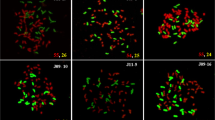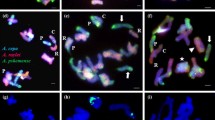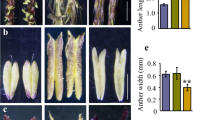Abstract
A hybrid between Erianthus arundinaceus (Retz.) Jeswiet and Saccharum spontaneum L. which are wild related species of sugarcane (Saccharum L., Family Poaceae), was repeatedly crossed as female parent with sugarcane commercial varieties to develop near commercial sugarcane clones. The cytoplasm type of the hybrid derivatives were confirmed to be of E. arundinaceus through the mitochondrial and chloroplast DNA polymorphism of nad 4/3-4 intron segment and psbC–trnS segment, respectively. The E. arundinaceus × S. spontaneum hybrid with somatic chromosome number 2n = 62 was confirmed to have 30 chromosomes from E. arundinaceus through genomic in situ hybridization (GISH). The (E. arundinaceus × S. spontaneum) × sugarcane hybrid (2n = 118) had 24 chromosomes from E. arundinaceus whereas its next generation hybrid with sugarcane (2n = 108) had only 12 Erianthus chromosomes. The commercial sugarcane hybrid Co 15015, which is the third generation hybrid with 2n = 106 was confirmed to have two E. arundinaceus chromosomes through GISH. It is the first report of sugarcane with both alien cytoplasm and chromosome contributions from E. arundinaceus.




Similar content being viewed by others
References
Besse P, McIntyre CL, Burner DM, de Almeida CG (1997) Using genomic slot blot hybridization to assess intergeneric Saccharum × Erianthus hybrids (Andropogoneae—Saccharinae). Genome 40:428–432
Cai Q, Aitken KS, Fan FH, Piperidis G, Jackson P, McIntyre CL (2005) A preliminary assessment of the genetic relationship between Erianthus rockii and the “Saccharum complex” using microsatellite (SSR) and AFLP markers. Plant Sci 169(5):976–984
D’Hont A, Grivet L, Feldmann P, Rao S, Berding N, Glaszmann JC (1996) Characterisation of the double genome structure of modern sugarcane cultivars (Saccharum spp.) by molecular cytogenetics. Mol Gen Genet 250:405–413
Daniels J, Roach BT (1987) Taxonomy and evolution. In: Heinz DJ (ed) Sugarcane improvement through breeding. Elsevier Press, Amsterdam, pp 7–84
Daniels J, Smith P, Paton N, Williams CA (1975) The origin of the genus Saccharum. Sugarcane Breed Newsl 36:24–39
D’Hont A, Rao P, Feldmann P, Grivet L, Islam-Faridi N, Taylor P, Glaszmann JC (1995) Identification and characterisation of sugarcane intergeneric hybrids, Saccharum officinarum × Erianthus arundinaceus, with molecular markers and DNA in situ hybridisation. Theor Appl Genet 91:320–326
Doyle JJ, Doyle JL (1990) Isolation of plant DNA from fresh tissue. Focus 12:13–15
Huang Y, Wu J, Wang P, Lin Y, Fu C, Deng Z, Wang Q, Li Q, Chen R, Zhang M (2015) Characterization of chromosome inheritance of the intergeneric BC2 and BC3 progeny between Saccharum spp. and E. arundinaceus. PLoS ONE 10(7):e0133722. doi:10.1371/journal.pone.0133722
Lalitha R, Premachandran MN (2007) Meiotic abnormalities in intergeneric hybrids between Saccharum spontaneum and Erianthus arundinaceus (Gramineae). Cytologia 72:337–343
Mangelsdorf AJ (1983) Cytoplasmic diversity in relation to pests and pathogens. ISSCT Sugarcane Breed Newsl 45:45–49
Mukherjee SK (1957) Origin and distribution of Saccharum. Bot Gaz 119:55–61
Nerkar G, Farsangi F, Devarumath R (2015) Organellar genome diversity in Saccharum and Erianthus spp. revealed by PCR-RFLP. Mol Plant Breed 6(11):1–11
Piperidis G, Christopher MJ, Carroll BJ, Berding N, D’Hont A (2000) Molecular contribution to selection of intergeneric hybrids between sugarcane and the wild species Erianthus arundinaceus. Genome 43:1033–1037
Piperidis N, Chen J, Deng H, Wang L, Jackson P, Piperidis G (2010) GISH characterization of Erianthus arundinaceus chromosomes in three generations of sugarcane intergeneric hybrids. Genome 53:331–336
Premachandran MN, Arvinth S, Lalitha R (2006) Chloroplast DNA polymorphism in psbC-trnS and trnL intron segments differentiate Saccharum and Erianthus. Indian J Genet Plant Breed 66:283–286
Price S (1963) Cytogenetics of modern sugarcanes. Econ Bot 17:97–105
Premachandran MN, Raffee Viola V, Lalitha R, Lekshmi M, Remadevi, AK (2011) Saccharum spontaneum as a bridge species for introgression of Erianthus arundinaceus and E. bengalense traits to sugarcane. In: Proceedings of the international sugar conference IS 2011, Balancing sugar and energy production in developing countries: Sustainable technologies and marketing technologies, New Delhi, pp 521–526
Roach BT (1989) Origin and improvement of the genetic base of sugarcane. In: Proceedings of the Australian Society of sugar cane technologists, Brisbane, pp 35–47
Sreenivasan TV, Ahloowalia BS, Heinz DJ (1987) Cytogenetics. In: Heinz DJ (ed) Sugarcane improvement through breeding. Elsevier, Amsterdam, pp 211–253
Tatum LA (1971) The southern corn leaf blight epidemic. Science 171:1113–1116
Tew TL (1987) New varieties. In: Heinz DJ (ed) Sugarcane improvement through breeding. Elsevier, Amsterdam, pp 560–594
Viola VR, Lekshmi M, Premachandran MN (2011) Differentiation of cytoplasm of Saccharum and Erianthus species by mitochondrial DNA polymorphism. Indian J Genet Plant Breed 71:1–3
Wu J, Huang Y, Lin Y, Fu C, Liu S, Deng Z, Li Q, Huang Z, Chen R, Zhang R (2014) Unexpected inheritance pattern of Erianthus arundinaceus chromosomes in the intergeneric progeny between Saccharum spp. and Erianthus arundinaceus. PLoS ONE 9(10):e110390
Acknowledgments
The authors are grateful to Director, ICAR-Sugarcane Breeding Institute for his constant encouragement during the course of this study. We are also grateful to Genetic Transformation Laboratory, ICAR-Sugarcane Breeding Institute for providing all the lab facilities. Technical support given by Ms. A. K. Remadevi is greatly acknowledged.
Author information
Authors and Affiliations
Corresponding author
Ethics declarations
Conflict of interest
The authors declare that they have no conflict of interest.
Rights and permissions
About this article
Cite this article
Lekshmi, M., Pazhany, A.S., Sobhakumari, V.P. et al. Nuclear and cytoplasmic contributions from Erianthus arundinaceus (Retz.) Jeswiet in a sugarcane hybrid clone confirmed through genomic in situ hybridization and cytoplasmic DNA polymorphism. Genet Resour Crop Evol 64, 1553–1560 (2017). https://doi.org/10.1007/s10722-016-0453-5
Received:
Accepted:
Published:
Issue Date:
DOI: https://doi.org/10.1007/s10722-016-0453-5




